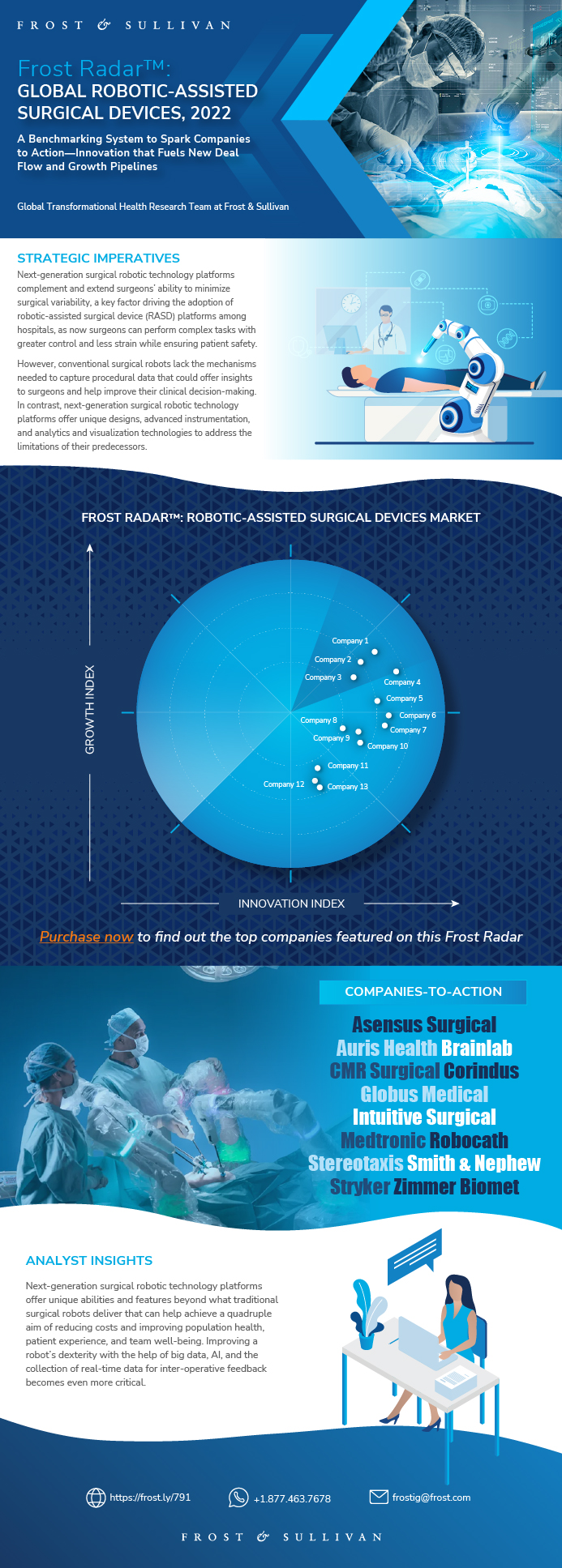Frost Radar™: Global Robotic-assisted Surgical Devices, 2022
Frost Radar™: Global Robotic-assisted Surgical Devices, 2022
A Benchmarking System to Spark Companies to Action - Innovation that Fuels New Deal Flow and Growth Pipelines
29-Mar-2022
North America
$4,950.00
Special Price $3,712.50 save 25 %
Description
As the healthcare industry continues adjusting to the increasing diagnosis of lifestyle-related diseases and demand for affordable care, effective surgical procedures assisted by robotic devices and a decline in treatment costs look promising. Next-generation surgical robotic technology platforms complement and extend surgeons’ ability to minimize surgical variability, a key factor driving adoption of robotic-assisted surgical device (RASD) platforms among hospitals, as now surgeons can perform complex tasks with greater control and less strain while ensuring patient safety.
The need to gain experience before robotic-assisted surgery remains debatable; however, the transition from a laparoscopic surgeon to a robotic surgeon is associated with a shorter learning period. Hence, several medical and research institutes in the United States and Europe now offer robotic surgery training programs to ensure more surgeons have the expertise and skills needed, but with a shorter learning curve.
With the advancement of digital and analytical technologies, deployment of artificial intelligence (AI) technologies, including machine learning and machine vision, in next-generation surgical platforms enables the systems to offer insights to surgeons based on analysis of the data collected. Moreover, haptic feedback signals when the pressure threshold is reached as a way to prevent damaging anatomical structures.
Partnerships between next-generation surgical robotic platform manufacturers and software developers; use of flexible payment and leasing business models; and focus on improved ergonomics, multi-quadrant surgeries, and reduced surgeon burnout and occupation-related disease acquisition are the key trends in this area. Frost & Sullivan believes that the adoption of next-generation surgical robotic technology platforms will increase inpatient surgery volumes by reducing patients’ length of stay (LOS) and thus offer a significant cost advantage for hospitals.
Surgical robot vendors and manufacturers must create a robust pipeline of RASD that will empower healthcare organizations with digital health tools and capabilities, including secure data storage, data interoperability, and networking.
In a field of about 40 industry participants, Frost & Sullivan independently plotted in this Frost Radar™ analysis the top 13 companies that generated revenue from robotic platforms between 2018 and 2021 and are actively marketing, installing, and developing next-generation surgical robotic technology platforms. The Frost Radar™ reveals the market positioning of each company using their Growth and Innovation scores as highlighted in the Frost Radar™ methodology. The document presents competitive profiles based on the companies’ strengths, opportunities, and a small discussion on their positioning.
Author: Bejoy Daniel
RESEARCH: INFOGRAPHIC
This infographic presents a brief overview of the research, and highlights the key topics discussed in it.Click image to view it in full size

Table of Contents
Strategic Imperative
Strategic Imperative (continued)
Growth Environment
Growth Environment (continued)
Growth Environment (continued)
Growth Environment (continued)
Frost Radar™: Robotic-assisted Surgical Devices Market
Frost Radar™: Competitive Environment
Frost Radar™: Competitive Environment (continued)
Frost Radar™: Competitive Environment (continued)
Frost Radar™: Competitive Environment (continued)
Asensus Surgical
Auris Health
Brainlab
CMR Surgical
Corindus
Globus Medical
Intuitive Surgical
Medtronic
Robocath
Stereotaxis
Smith & Nephew
Stryker
Zimmer Biomet
Strategic Insights
Significance of Being on the Frost Radar™
Frost Radar™ Empowers the CEO’s Growth Team
Frost Radar™ Empowers Investors
Frost Radar™ Empowers Customers
Frost Radar™ Empowers the Board of Directors
Frost Radar™: Benchmarking Future Growth Potential
Frost Radar™: Benchmarking Future Growth Potential
Legal Disclaimer
Popular Topics
| Author | Bejoy Daniel |
|---|---|
| GPS Codes | 9600-B1,9A47-B1,9A48-B1,9A49-B1,9A4B-B1 |
| Industries | Healthcare |
| No Index | No |
| Is Prebook | No |
| Podcast | No |
| WIP Number | MG82-01-00-00-00 |
 USD
USD GBP
GBP CNY
CNY EUR
EUR INR
INR JPY
JPY MYR
MYR ZAR
ZAR KRW
KRW THB
THB